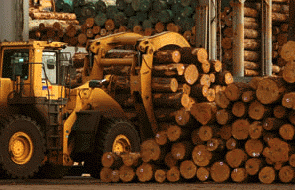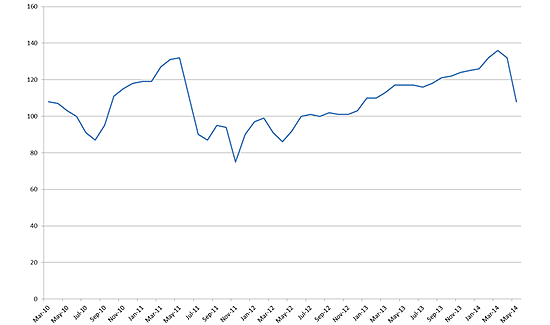
 April’s relatively small reduction in export log prices was followed by much larger reductions in May – some prices down as much as $25/JAS m3.
April’s relatively small reduction in export log prices was followed by much larger reductions in May – some prices down as much as $25/JAS m3.
In just two months, export log prices lost 14 months of prior month on month gains.
May export log prices are now equivalent to prices in January 2013. As usual, domestic prices were a lot less volatile and demand for domestic logs is generally strong.
Export Log Market
The rapid growth in the value of log exports from New Zealand reversed in May.
Latest figures from Statistics New Zealand show that the value of New Zealand log exports went from $1.6 billion in 2012 to $2.4 billion in 2013, accounting for 42% of our forestry product exports by value, compared with just three per cent in 1993.
The rapid increase in value is due to both volume and price increases.
In 2013, New Zealand exported 16.6m m3 of logs putting New Zealand up with the top three softwood log exporters in the world, and the largest log exporter to China. The value of log exports to China increased in value from $1b in 2012 to $1.7b dollars in 2013.
Forestry continues to be New Zealand’s third-largest goods export after dairy and meat.
Prices have steadily increased since April 2012 but then dropped dramatically in the past two months.
The large drop in price in May was primarily due to high log inventory at Chinese ports.
Over the 25 ports PF Olsen monitors, inventory has increased from 2 mln m3 to 4 mln m3.
The CFR price for NZ Radiata pine logs (the US$ price paid for logs delivered to ports in China) has fallen from a high of US$162/JAS m3 for A grade to a current price of around US$140/JAS m3. This has been the most influential factor affecting NZ$ at-wharf-gate prices. The exchange rate and ocean freight costs over the past two months have had only a minor impact on NZ log prices.
High log inventory is visually obvious – is takes up a lot of space – and is therefore a strong play for market participants to use in price negotiation.
It’s important to note that many log purchasers in China don’t necessarily want the price to drop (it means they are then carrying expensive inventory), but when it does drop (and this can be a single sale), it drops rapidly as buyers all want to lower their average purchase price. At some point, the market considers that the bottom of the price drop has been reached, and buyers “back up the truck” to have large volumes at the lowest price. The speed and extent of this recovery depends on market perception which will be influenced by log inventory levels.
There are several reasons which support the view of a relatively quick market recovery:
1. Despite the increase in log inventory, off-take has increased from a daily level of 46,000 m3 per day in January 2014 to 68,000 m3 per day in April 2014, an increase of 48%. These means stock turn has deteriorated from only 1.8 months in January to 1.9 months in April (so long as off-take remains robust).
2. We are still several months from the Chinese “hot season” during which log consumption slows as workers divert to harvesting summer crops.
3. Some of the recent increase in log deliveries to China was a result of Russia retaliating to European sanctions and diverting logs that otherwise would have gone to Europe to China. This is expected to be a one-off as Russia suffered significant losses from this exercise and is not expected to repeat it.
4. Some seasonal slowdown in deliveries is expected from New Zealand and Russia. New Zealand will also divert some volume to Korea and India.
5. While Chinese authorities want a slow down in the Chinese property market, they don’t want a collapse and the government has considerable resources and political will to influence achieving this balance.
Based on these factors, most market commentators are expecting a further drop in price in June, and then a recovery over the next few months.

While log stocks have doubled at China ports in the last four months, off-take has increased 48% over the same period.
Domestic Log Market
The New Zealand house construction market continues to grow strongly.
NZ building consents for the past twelve months are 12% up on the prior period. Residential building consents for the three months to February are up 24% driven mainly by growth in Auckland and Canterbury.
Australian building consents are also showing good growth. In the past 6 months to February there has been a 20% increase from the same period last year and consents are now well above the five year average rate for Australia.
The housing market in the US, on the other hand, has slowed.
This is due to severe winter storms earlier in the year crimping building activity and investors withdrawing from the housing market.
Sales of previously owned properties tumbled 7.5% in March from the previous year to the slowest pace in 20 months. Applications for mortgages to buy homes are down 21% from this time last year.
What is becoming apparent is that the first phase of strength in the housing recovery in the US was driven by investors seizing the opportunity to snatch up cheap real estate assets that produced high yields from rentals. Now that house prices have risen steeply from the market lows in early 2012, departing investor-buyers are not being replaced by owner-occupier buyers who are facing higher house prices along with rising mortgage interest rates.
According to Bloomberg Business Week, housing woes are slowing the US economic recovery. This is flowing on into the lumber market with weak demand and prices.
For New Zealand log processors, the relatively strong New Zealand and Australian markets provides good outlets for structural and engineered wood products.
The weakening Chinese markets will be less favourable for clear and low-grade wood products. Other processors with niche sales into other south-east Asian markets and Europe appear to be holding their own.
Since many domestic supply is negotiated quarterly, there has been little price impact on domestic logs.
PF Olsen’s log price index fell $10 to $104. This was driven by large price decreases in export logs.
PF Olsen Log Price Index

Basis of Index: This Index is based on prices in the table below weighted in proportions that represent a broad average of log grades produced from a typical pruned forest with an approximate mix of 45/55 domestic/export log supply.
Indicative Average Current Log Prices
| Log Grade | $/tonne at mill | $/JAS m3 at wharf |
| Pruned (P40) | 147 | 140 |
| Structural (S30) | 114 | |
| Structural (S20) | 101 | |
| Export A | 108 | |
| Export K | 97 | |
| Export KI | 89 | |
| Pulp | 50 |
Note: Actual prices will vary according to regional supply/demand balances, varying cost structures and grade variation. These prices should be used as a guide only and specific advice sought for individual forests.
---------------------------------------------------------------
This item is reproduced from PF Olsen's Wood Matters, with permission.
We welcome your comments below. If you are not already registered, please register to comment
Remember we welcome robust, respectful and insightful debate. We don't welcome abusive or defamatory comments and will de-register those repeatedly making such comments. Our current comment policy is here.